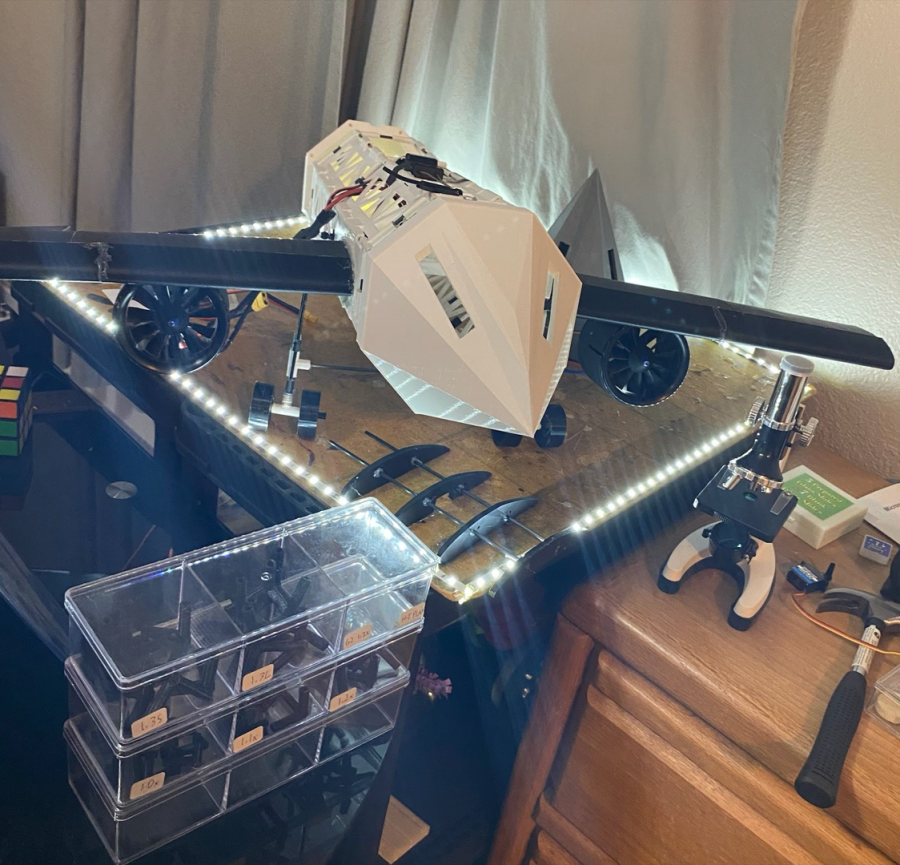Adventures with aerodynamics
February 15, 2023
A semi-completed modular aircraft – a snapshot of Jesse’s third- and fourth-year ISEF projects. He is excited for the fair this year!
Some students who walk through the hallways of Wilsonville High School are inventors– both as a hobby and as a means to better society as a whole.
Jesse Hayworth, a senior, has worked on aviation-based projects for many years, but from a different perspective. He was inspired by a YouTube documentary on ground effect vehicles during freshman year, and thought, “Why don’t I try, right? Just put some foam board together; get a basic fan set up and see if I can get something that can fly.”
So, freshman year he built a ground effect vehicle, which is “like a hovercraft.” He used foam to build the model plane, and got mentorship from ISEF advisors and Robotics mentors, especially when it came to electrical skills. He ended with a model which flew at 10 to 15 miles per hour at 0.5 meters off the ground, and the model itself was 1.25 meters long and 1 meter in length.
The following year, he built a jet engine. His goal was “to make a jet engine for as cheap as [he] possibly could,” and managed to get the cost down to about 300 dollars. He learned to weld materials together from a kit to make this jet engine.
During Hayworth’s junior year, he wanted to make pieces (like LEGOs) which could “be fit together to construct vehicles.” Using carbon fiber rods and custom 3D printed parts which fit around the rods, he formed vehicle frames. This year, he’s continuing the project “to allow for modular aircraft that includes modular flaps, those kinds of things,” which will help build “pretty cheap and printable aircraft” in the future.
Speaking of the future, Hayworth definitely wants to join the aviation and aerospace industry, and is thankful for the technical support he has gotten through the ISEF and Robotics programs at WVHS.
Junior Paul Liu also has a knack for aerodynamic inventions. This year, he’s working on a “noise and drag reduction system on the side mirror for cars” with his sophomore teammate Ronak Sameer-Asita.
Liu explained that his invention works best for driving in straight lines. “For example,” he commented, “on the highway… the car will have a system on the mirror cap which will open up and allow more airflow to go through the system,” therefore reducing turbulence. This mechanical addition to a car mirror will also reduce wind noise.
Liu’s inspiration for the drag reduction system was watching F1. He said F1 cars “have a drag reduction system, but on the rear of the car on the wing. And this has never been done on a normal car.” Normal cars don’t have wings, so Liu and Sameer-Asita considered other parts of cars which connected the air a lot: the mirrors were completely exposed and produced a lot of drag.
Liu mentioned that they are “currently building and testing right now.” Based on their design, they hope to “improve miles per gallon by at least one percent.”
This school prepares students to make changes in the world in the future– but know that, with the great resources our school provides, students can make a change right now.
